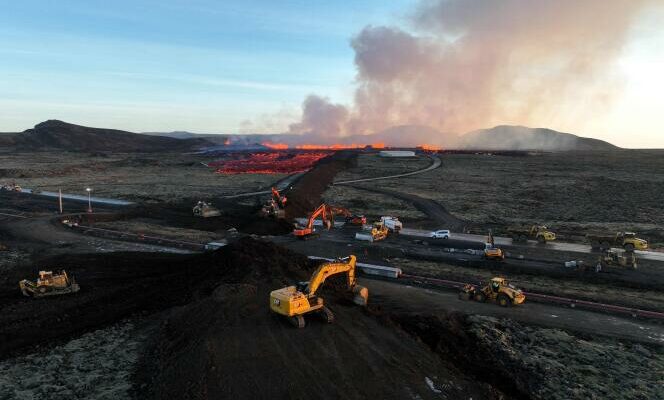A new eruption of the Sundhnjukagigar volcano began on Sunday January 14 at 8 o’clock, north of the town of Grindavik in Iceland (South-West), after a previous one in December 2023, announced the Icelandic Meteorological Office (IMO).
Seismic activity accelerated sharply overnight and residents of Grindavik were evacuated around 3 a.m. local time, according to Icelandic Public Radio and Television. Surveillance footage showing large flows of bright orange lava along a fissure in the Icelandic sunrise.
The Office announced at the beginning of the morning that this first crack had been created “on both sides of the defenses which began to be built to the north of Grindavík”, “about 450 meters from the northernmost houses of the town”. “A new fissure has opened just outside the city limits of Grindavik”he said in a new bulletin at midday.
“The city has already been successfully evacuated overnight and no lives are in danger, but infrastructure could be at risk. Flights are not interrupted »Icelandic President Gudni Johannesson said in a message on.For the mayor of Grindavik, Fannar Jonasson, the new crack “creates a new situation” but ” we can not do anything “he told RUV, considering the situation worrying.
Repeated evacuation order
This is the fifth volcanic eruption in Iceland in two years, the latest, that of the Sundhnjukagigar volcano, having taken place on the evening of December 18, 2023, in this area located southwest of the capital Reykjavik.
The town of Grindavik, which has 4,000 inhabitants, was evacuated on November 11, 2023 as a precaution, after hundreds of earthquakes caused by the movement of magma under the earth’s crust – a precursor to a volcanic eruption.
These earthquakes damaged the city, creating large cracks in the roads and in houses and public buildings. Since then, residents have had the right to return there briefly and then without warning since December 23, before being urgently evacuated yesterday night. Only a few dozen residents had returned to their homes.
Four days after the December 18 eruption, authorities declared that volcanic activity had stopped, but could not say whether the eruption was over, due to possible lava flows underground.
One death on Wednesday due to seismic activity
The evacuation order ordered on Saturday evening for Grindavik, due to the resumption of seismic activity, also follows the death on Wednesday of a 51-year-old Icelander, who was working to fill a crevasse in a private garden when the ground suddenly gave way under his feet.
Newsletter
” Human warmth “
How to face the climate challenge? Every week, our best articles on the subject
Register
After intense searches for forty-eight hours, the authorities decided to put an end to it Friday evening due to the dangerous nature of the place. The man, who was not found, had fallen more than 30 meters into a crevasse.
The authorities are also carefully monitoring the Svartsengi geothermal power plant, located in the same sector and which provides electricity and water to around 30,000 inhabitants of the region, and whose installations are protected by a wall. “What matters is where the lava flows. It is now very important to monitor her”explained Kristin Jonsdottir, IMO volcanologist at RUV.
Until the March 2021 eruption, the Reykjanes Peninsula, south of the capital Reykjavik, had been spared from eruptions for eight centuries.
Thirty-two volcanic systems are considered active in this country of fire and ice, the most volcanic region in Europe.
